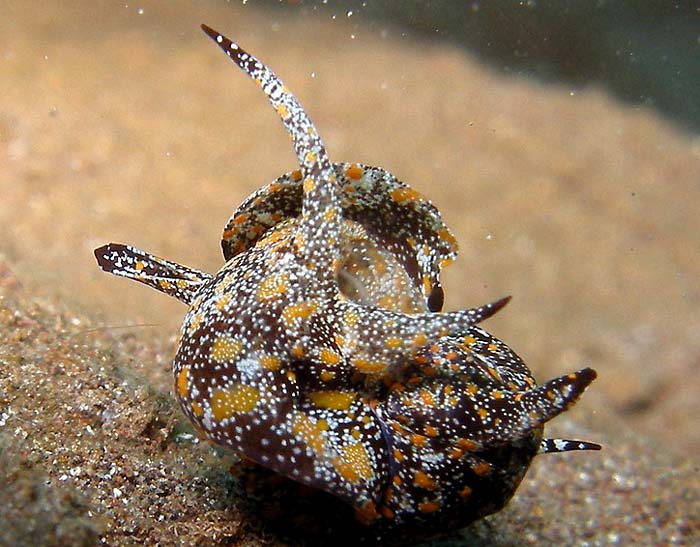This species has been observed on Mayotte Island
Species characteristics : It has two dorsal conical appendages (bicornutum) on the posterior shield and an elongate filament on the posterior end of the foot Dark brown background with numerous little white spots and large orange/yellow area
|

|
|
| Showing species characteristics... | Photo Emmanuelle Aigle |
|
Remarks :
Identification confirmed by Nathalie Yonow µ
Synonymous : (according Worms)
- No other name
Bibliographic data :
In some specimen, the animal was translucent with scattered spots of orange/yellow, brown and white. In our specimens the translucent color disappeared, all the body seems to be covered by brown pigment and white and orange/yellow spots.
This species is found crawling on sand in relatively shallow water in 3-10 m of water
References :
Bill Rudman Seaslug site : Sea Slug Forum : Gastropteron bicornutum
Nudipixel Gastropteron bicornutum
Publications :
Baba, K. & Tokioka, T. (1965) Two more new species of Gastropteron from Japan, with further notes on G. flavum T. & B. (Gastropoda : Opisthobranchia). Publications of the Seto Marine Biological Laboratory, 12(5) : 363-377, Text-figs 1-8, Pl.25.
Baba, K. (1970) List of the Gastropteridae and Runcinidae from Japan. Collecting and Breeding, 32(2) : 46-48
Gosliner, T.M. (1989) Revision of the Gastropteridae (Opisthobranchia: Cephalaspidea) with descriptions of a new genus and six new species. The Veliger, 32(4) : 333-381. (Figs 1-32)
Other photos of Gastropteron bicornutum :
 |
Emmanuelle Aigle Mayotte, Mliha, 6 m, 3 December 2009, size : 20 mm Several specimens crawling on the sand, and some specimen "swimming"...with mouvements of the parapodia... Mating behavior on the sand...
|
More photos from Indian Ocean